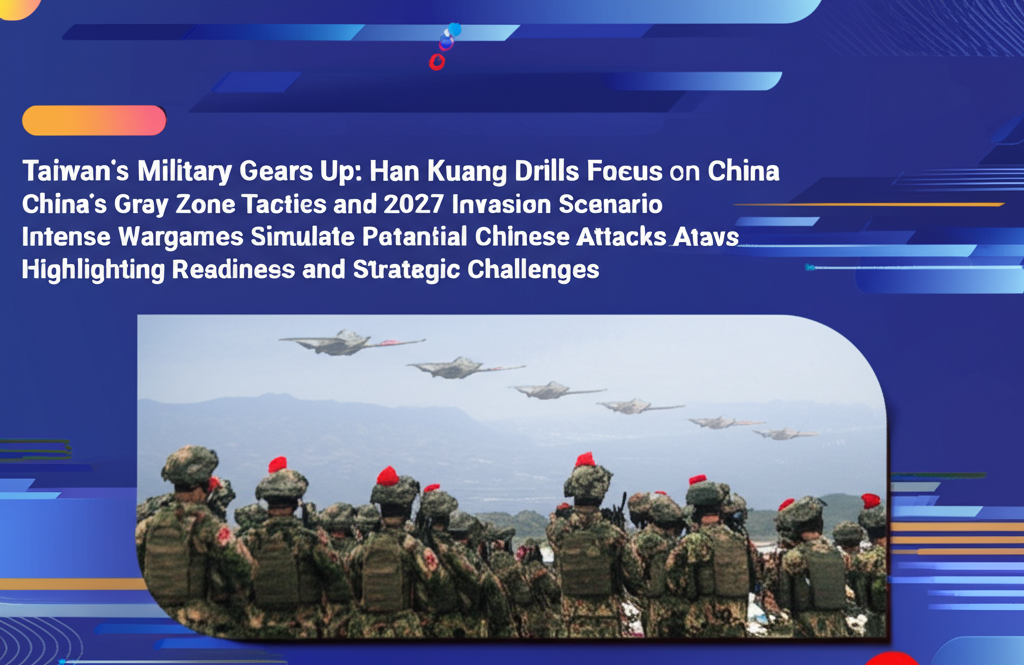Taiwan's Military Gears Up: Han Kuang Drills Focus on China's Gray Zone Tactics and 2027 Invasion Scenario
Intense Wargames Simulate Potential Chinese Attacks, Highlighting Taiwan's Readiness and Strategic Challenges

Taipei, April 5 – Taiwan's annual Han Kuang military exercises, a crucial part of its defense strategy, commenced with a focus on China's growing "gray zone" activities and the potential for a full-scale invasion.
The 41st edition of the Han Kuang exercises began with extensive computer-aided wargames, utilizing the U.S.-built Joint Theater Level Simulation (JTLS) platform. The live-fire phase is scheduled for July 9-18.
Major General Tung Chi-hsing (董冀星), director of the Ministry of National Defense's (MND) joint operations planning division, confirmed that the wargames will simulate scenarios where the People's Liberation Army (PLA) exercises could escalate into a real attack on Taiwan.
The Han Kuang exercises will also simulate PLA "gray zone" activities, which involve provocative actions just short of open conflict, according to Tung.
Legislator Wang Ting-yu (王定宇) of the Democratic Progressive Party (DPP) indicated the 2025 wargames will be longer than previous years, spanning two weeks, signifying expanded simulation efforts.
Wang, a member of the Legislature's Foreign Affairs and National Defense Committee, stated that the public now recognizes the "first strike" could involve maritime militia vessels, sand dredgers, and drones, often used in "gray zone" operations.
He emphasized the need for Taiwan's military to handle situations beyond traditional force-on-force confrontations, including responding to "gray zone" activities within international law, while preventing escalation.
These intricate scenarios necessitate detailed planning and simulation, leading to longer wargame durations, as Wang explained.
Su Tzu-yun (蘇紫雲), director of the Division of Defense Strategy and Resources at the Taiwan's Institute for National Defense and Security Research, agreed that the extended two-week wargame duration is likely to incorporate more "gray zone" scenarios.
Su noted that the PLA usually deploys six to 10 warships around Taiwan during naval and air patrols.
He further explained that if each warship carried vertical launching systems, approximately 500 land-attack cruise missiles could target Taiwan, reaching their targets within three minutes.
This short response time underscores the importance of simulating such scenarios, especially as PLA warships' presence increases.
Preparing for 2027
Su also mentioned that Defense Minister Wellington Koo (顧立雄) stated the Han Kuang exercises are based on a hypothetical PLA invasion in 2027.
Su listed several milestones in 2027, including the PLA's 100th anniversary, President Xi Jinping (習近平)'s fourth term, and the 12th year of ongoing military reforms, potentially motivating Xi to take action, even a full-scale invasion.
The exercises' focus on a possible 2027 invasion reflects a "worst-case scenario" and risk management approach by Taiwan's military, according to Su.
This year's exercises will test how the MND would respond in a 2027 invasion and evaluate the readiness of Taiwan's armed forces and their weaponry, Su said.
The year 2027 is seen by some military experts as a potential flashpoint for Chinese military action against Taiwan. This came to the fore in 2021, when Philip Davidson, who was then head of the U.S. Indo-Pacific Command, said that Taiwan was "clearly one of their [China's] ambitions" and warned that "the threat is manifest during this decade, in fact, in the next six years."
Since then, the year 2027 has been referred to as the "Davidson window," with several U.S. military and political figures warning that China is aiming to develop the capability to invade Taiwan by 2027 and that both the U.S. and Taiwan should be prepared for such an eventuality.
